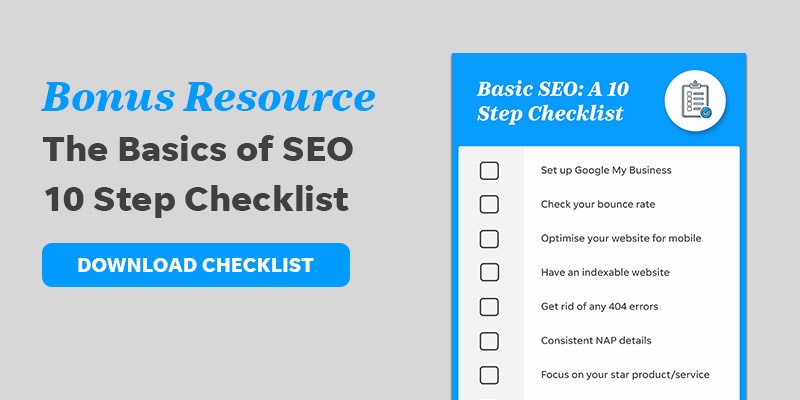Before you delve into on-site SEO (Search Engine Optimisation), off-page SEO, technical SEO, and local SEO, let’s go back to basics.
Basic SEO strategies involve the first, baby steps you need to take to fluff up your website for successful search engine optimisation.
Once you have strategies for basic SEO in place, you can begin to branch out into other aspects of more advanced SEO. But for now, let’s trim the fat!
Where Should You Start With SEO?
Once you have familiarised yourself with what SEO means, you’ll be thinking about everything you need to put in place to drive traffic to your website and increase your web page ranking. Taking the following, initial steps will put you in good stead to work on the meatier, on–page SEO factors later.
Set Up Google My Business
If you are a local business or have physical, local branches, create a Google My Business account if you have not already done so. If your business is already claimed, you must follow the steps to claim your business back. The good news? It’s free, and it means anyone can find you! Think of it as your online shop window. You can read our handy guide to creating a Google My Business profile here. If you’re not sure if you need a Google My Business listing, then check out our take on local SEO vs. national SEO.
Check Your Bounce Rate
A bounce rate that is deemed excellent is between 26% and 40%. The higher your bounce rate, the more visitors are clicking back off and leaving your site. But why? Consider these factors; is it out of date? Does it have visual appeal? Is the navigation easy and straight forward? What is the load time? Your bounce rate affects your SEO – a high bounce rate tells Google that your website isn’t worth visiting. You can use Google Analytics to discover your bounce rate.
Optimise Your Website For Mobile
You can do Google’s mobile friendly test to see if your website is fully optimised for all devices. Nowadays, website’s need to be adaptive to all types of tablets and mobiles. After all, 55% of searches are conducted from a mobile phone!
Have An Indexable Website
Website indexation is a fancy term for the process by which a search engine adds web content to its search engine results pages. When somebody makes an online search, search engines crawl thousands of webpages across the internet for keywords, metadata, and related signals that tell search engines that the content on a website matches the user search criteria – and in what position websites should be ranked depending on how well they match. If your website isn’t easy to index for a search engine, it isn’t going to have a chance of appearing on page 1! Have a look at our technical SEO starter steps to get further tips on indexation.
Get Rid Of The Dreaded 404
If you have broken links on your website that display ‘error: 404’ or similar, such inefficiencies will negatively impact your website ranking. Give your website a spring clean and a dusting off by eradicating any dodgy URLs or problem pages. Broken Link Checker may help you identify your broken links.
Consistent NAP
If Google notices even the slightest variation in the contact details listed across your website, other websites, online directories and GMB profile, you’re going down, quite literally! Google even takes punctuation and spaces into account, so revise all your business and contact credentials and ensure they match exactly across the internet.
Focus On Your Star Product/Service
If you have a standout product or service that drives the most traffic, or a key area you want to rank higher for, feature that more prominently on your website. Create interesting and informative content around the subject to boost your website’s ranking and visibility. You can read more about creating content to boost your SEO here.
Do Your (Keyword) Research!
Conduct free keyword research using Google’s Keyword Planner to assist you. Think about what your target customers are searching online for and consider what you want to rank for. Work on a high-quality list of keywords to embed into to your website content, but ensure you do so in a natural way. The keywords should naturally compliment and support your content, otherwise it will seem robotic and lack sense. Don’t forget to use question led and longer tail keywords in your content due to the ever increasing popularity of voice search.
Utilise Plug-Ins & Tools For SEO
All reputable website builders, such as WordPress, have plug-ins for SEO that you can install to help you identify the strengths and weaknesses of your website, highlighting where you need to improve. And guess what, some are even free!
Regularly Refresh Your Website
Update your website frequently, by creating informative, helpful content on a periodic basis. Enhance your SEO further by using keywords and links to other reputable websites and recent, relevant articles you would like to be associated with – stay clear of spam sites! Think about the structure of your SEO content – having a clean layout organised with headers, sub-headers and bulleted lists not only makes it easier for the reader to digest, and it also helps search engines index your site quicker.
And Relax!
SEO is a middle to long-term strategy, and you can also keep a watchful eye on the performance and by using Google Analytics and Google Search Console. there is no overnight quick fix, so do what you can now and ensure you are constantly working on your websites upkeep.
If you’re feeling inspired to take over the world via SERPs, you can dive further into SEO with our practical and helpful free SEO guide. To chat about our SEO service, contact us here.






